Bactericidal/Permeability-Increasing Protein Downregulates the Inflammatory Response in In Vivo Models of Arthritis
Abstract
1. Introduction
2. Results
2.1. Effects of BPI Treatment on Collagen-Induced Arthritis
2.1.1. Clinical and Histological Assessments
2.1.2. Cytokine Serum Levels
2.2. Effects of BPI Treatment on Crystal-Induced Inflammation
3. Discussion
4. Materials and Methods
4.1. Animals
4.2. Murine Model of Collagen-Induced Arthritis (CIA)
4.2.1. Arthritis Induction
4.2.2. Treatment
4.2.3. White Blood Cell Counts, Serum Cytokine Determination, and Histological Evaluation
4.3. In Vivo Model of Crystal-Induced Inflammation
4.3.1. Preparation of Monosodium Urate and Calcium Pyrophosphate Crystals
4.3.2. Induction of Inflammation and Treatment
4.4. Statistical Analysis
5. Conclusions
6. Patents
Supplementary Materials
Author Contributions
Funding
Institutional Review Board Statement
Informed Consent Statement
Data Availability Statement
Conflicts of Interest
References
- Scott, D.L.; Wolfe, F.; Huizinga, T.W.J. Rheumatoid Arthritis. Lancet 2010, 376, 1094–1108. [Google Scholar] [CrossRef]
- Schumacher, H.R. Crystal-Induced Arthritis: An Overview. Am. J. Med. 1996, 100, 46S–52S. [Google Scholar] [CrossRef]
- Sakthiswary, R.; Uma Veshaaliini, R.; Chin, K.-Y.; Das, S.; Sirasanagandla, S.R. Pathomechanisms of Bone Loss in Rheumatoid Arthritis. Front. Med. 2022, 9, 962969. [Google Scholar] [CrossRef] [PubMed]
- McInnes, I.B.; Schett, G. Cytokines in the Pathogenesis of Rheumatoid Arthritis. Nat. Rev. Immunol. 2007, 7, 429–442. [Google Scholar] [CrossRef]
- Punzi, L.; Scanu, A.; Ramonda, R.; Oliviero, F. Gout as Autoinflammatory Disease: New Mechanisms for More Appropriated Treatment Targets. Autoimmun. Rev. 2012, 12, 66–71. [Google Scholar] [CrossRef] [PubMed]
- Galozzi, P.; Bindoli, S.; Luisetto, R.; Sfriso, P.; Ramonda, R.; Scanu, A.; Oliviero, F. Regulation of Crystal Induced Inflammation: Current Understandings and Clinical Implications. Expert Rev. Clin. Immunol. 2021, 17, 773–787. [Google Scholar] [CrossRef] [PubMed]
- Reichel, P.H.; Seemann, C.; Csernok, E.; Schröder, J.M.; Müller, A.; Gross, W.L.; Schultz, H. Bactericidal/Permeability-Increasing Protein Is Expressed by Human Dermal Fibroblasts and Upregulated by Interleukin 4. Clin. Diagn. Lab. Immunol. 2003, 10, 473–475. [Google Scholar] [CrossRef]
- Canny, G.; Levy, O.; Furuta, G.T.; Narravula-Alipati, S.; Sisson, R.B.; Serhan, C.N.; Colgan, S.P. Lipid Mediator-Induced Expression of Bactericidal/Permeability-Increasing Protein (BPI) in Human Mucosal Epithelia. Proc. Natl. Acad. Sci. USA 2002, 99, 3902–3907. [Google Scholar] [CrossRef]
- Schultz, H.; Weiss, J.P. The Bactericidal/Permeability-Increasing Protein (BPI) in Infection and Inflammatory Disease. Clin. Chim. Acta 2007, 384, 12–23. [Google Scholar] [CrossRef]
- Mannion, B.A.; Weiss, J.; Elsbach, P. Separation of Sublethal and Lethal Effects of the Bactericidal/Permeability Increasing Protein on Escherichia coli. J. Clin. Investig. 1990, 85, 853–860. [Google Scholar] [CrossRef]
- Marra, M.N.; Wilde, C.G.; Griffith, J.E.; Snable, J.L.; Scott, R.W. Bactericidal/Permeability-Increasing Protein Has Endotoxin- Neutralizing Activity. J. Immunol. 1990, 144, 662–666. [Google Scholar] [PubMed]
- Iovine, N.M.; Elsbach, P.; Weiss, J. An Opsonic Function of the Neutrophil Bactericidal/Permeability-Increasing Protein Depends on Both Its N- and C-Terminal Domains. Proc. Natl. Acad. Sci. USA 1997, 94, 10973–10978. [Google Scholar] [CrossRef] [PubMed]
- Canny, G.; Levy, O. Bactericidal/Permeability-Increasing Protein (BPI) and BPI Homologs at Mucosal Sites. Trends Immunol. 2008, 29, 541–547. [Google Scholar] [CrossRef] [PubMed]
- van der Schaft, D.W.J.; Toebes, E.A.H.; Haseman, J.R.; Mayo, K.H.; Griffioen, A.W. Bactericidal/Permeability-Increasing Protein (BPI) Inhibits Angiogenesis via Induction of Apoptosis in Vascular Endothelial Cells. Blood 2000, 96, 176–181. [Google Scholar] [CrossRef]
- Yamagata, M.; Rook, S.L.; Sassa, Y.; Ma, R.C.; Geraldes, P.; Goddard, L.; Clermont, A.; Gao, B.; Salti, H.; Gundel, R.; et al. Bactericidal/Permeability-increasing Protein’s Signaling Pathways and Its Retinal Trophic and Anti-angiogenic Effects. FASEB J. 2006, 20, 2058–2067. [Google Scholar] [CrossRef]
- Holweg, A.; Schnare, M.; Gessner, A. The Bactericidal/Permeability-Increasing Protein (BPI) in the Innate Defence of the Lower Airways. Biochem. Soc. Trans. 2011, 39, 1045–1050. [Google Scholar] [CrossRef][Green Version]
- Balakrishnan, A.; Chakravortty, D. Epithelial Cell Damage Activates Bactericidal/Permeability Increasing-Protein (BPI) Expression in Intestinal Epithelium. Front. Microbiol. 2017, 8, 1567. [Google Scholar] [CrossRef]
- Monajemi, H.; Meenan, J.; Lamping, R.; Obradov, D.O.; Radema, S.A.; Trown, P.W.; Tytgat, G.N.; van Deventer, S.J.H. Inflammatory Bowel Disease Is Associated with Increased Mucosal Levels of Bactericidal/Permeability-Increasing Protein. Gastroenterology 1996, 110, 733–739. [Google Scholar] [CrossRef]
- Punzi, L.; Peuravuori, H.; Jokilammi-Siltanen, A.; Bertazzolo, N.; Nevalainen, T.J. Bactericidal/Permeability Increasing Protein and Proinflammatory Cytokines in Synovial Fluid of Psoriatic Arthritis. Clin. Exp. Rheumatol. 2000, 18, 613–615. [Google Scholar]
- Bokarewa, M.I.; Jin, T.; Tarkowski, A. Intraarticular Release and Accumulation of Defensins and Bactericidal/Permeability-Increasing Protein in Patients with Rheumatoid Arthritis. J. Rheumatol. 2003, 30, 1719–1724. [Google Scholar]
- Theprungsirikul, J.; Skopelja-Gardner, S.; Rigby, W.F.C. Killing Three Birds with One BPI: Bactericidal, Opsonic, and Anti-Inflammatory Functions. J. Transl. Autoimmun. 2021, 4, 100105. [Google Scholar] [CrossRef] [PubMed]
- Marinho, A.; Nunes, C.; Reis, S. Hyaluronic Acid: A Key Ingredient in the Therapy of Inflammation. Biomolecules 2021, 11, 1518. [Google Scholar] [CrossRef]
- Altman, R.; Hackel, J.; Niazi, F.; Shaw, P.; Nicholls, M. Efficacy and Safety of Repeated Courses of Hyaluronic Acid Injections for Knee Osteoarthritis: A Systematic Review. Semin. Arthritis Rheum. 2018, 48, 168–175. [Google Scholar] [CrossRef] [PubMed]
- Li, C.; Cao, Z.; Li, W.; Liu, R.; Chen, Y.; Song, Y.; Liu, G.; Song, Z.; Liu, Z.; Lu, C.; et al. A Review on the Wide Range Applications of Hyaluronic Acid as a Promising Rejuvenating Biomacromolecule in the Treatments of Bone Related Diseases. Int. J. Biol. Macromol. 2020, 165, 1264–1275. [Google Scholar] [CrossRef] [PubMed]
- Gupta, R.C.; Lall, R.; Srivastava, A.; Sinha, A. Hyaluronic Acid: Molecular Mechanisms and Therapeutic Trajectory. Front. Vet. Sci. 2019, 6, 192. [Google Scholar] [CrossRef] [PubMed]
- Holmdahl, R.; Bockermann, R.; Bäcklund, J.; Yamada, H. The Molecular Pathogenesis of Collagen-Induced Arthritis in Mice—A Model for Rheumatoid Arthritis. Ageing Res. Rev. 2002, 1, 135–147. [Google Scholar] [CrossRef]
- Brand, D.D.; Kang, A.H.; Rosloniec, E.F. The Mouse Model of Collagen-Induced Arthritis. Methods Mol. Med. 2004, 102, 295–312. [Google Scholar] [CrossRef]
- Kany, S.; Vollrath, J.T.; Relja, B. Cytokines in Inflammatory Disease. Int. J. Mol. Sci. 2019, 20, 6008. [Google Scholar] [CrossRef]
- Moudgil, K.D.; Choubey, D. Cytokines in Autoimmunity: Role in Induction, Regulation, and Treatment. J. Interferon Cytokine Res. 2011, 31, 695–703. [Google Scholar] [CrossRef]
- Punzi, L.; Scanu, A.; Galozzi, P.; Luisetto, R.; Spinella, P.; Scirè, C.A.; Oliviero, F. One Year in Review 2020: Gout. Clin. Exp. Rheumatol. 2020, 38, 807–821. [Google Scholar]
- McCarthy, G.M.; Dunne, A. Calcium Crystal Deposition Diseases—beyond Gout. Nat. Rev. Rheumatol. 2018, 14, 592–602. [Google Scholar] [CrossRef] [PubMed]
- Feldmann, M.; Brennan, F.M.; Maini, R.N. Role of Cytokines in Rheumatoid Arthritis. Annu. Rev. Immunol. 1996, 14, 397–440. [Google Scholar] [CrossRef] [PubMed]
- Scanu, A.; Oliviero, F.; Ramonda, R.; Frallonardo, P.; Dayer, J.M.; Punzi, L. Cytokine Levels in Human Synovial Fluid during the Different Stages of Acute Gout: Role of Transforming Growth Factor Β1 in the Resolution Phase. Ann. Rheum. Dis. 2012, 71, 621–624. [Google Scholar] [CrossRef] [PubMed]
- Scanu, A.; Lorenzin, M.; Luisetto, R.; Galozzi, P.; Ortolan, A.; Oliviero, F.; Doria, A.; Ramonda, R. Identification in Synovial Fluid of a New Potential Pathogenic Player in Arthropathies. Exp. Biol. Med. 2022, 247, 1061–1066. [Google Scholar] [CrossRef]
- Wojdasiewicz, P.; Wajda, A.; Haładyj, E.; Romanowska-Próchnicka, K.; Felis-Giemza, A.; Nałęcz-Janik, J.; Walczyk, M.; Olesińska, M.; Tarnacka, B.; Paradowska-Gorycka, A. IL-35, TNF-α, BAFF, and VEGF Serum Levels in Patients with Different Rheumatic Diseases. Reumatologia 2019, 57, 145–150. [Google Scholar] [CrossRef]
- Paleolog, E.M. Angiogenesis in Rheumatoid Arthritis. Arthritis Res. 2002, 4 (Suppl. S3), S81–S90. [Google Scholar] [CrossRef]
- Lee, Y.H.; Bae, S.C. Correlation between Circulating VEGF Levels and Disease Activity in Rheumatoid Arthritis: A Meta-Analysis. Z. Rheumatol. 2018, 77, 240–248. [Google Scholar] [CrossRef]
- Le, T.H.V.; Kwon, S.M. Vascular Endothelial Growth Factor Biology and Its Potential as a Therapeutic Target in Rheumatic Diseases. Int. J. Mol. Sci. 2021, 22, 5387. [Google Scholar] [CrossRef]
- Van der Schaft, D.W.J.; Wagstaff, J.; Mayo, K.H.; Griffioen, A.W. The Antiangiogenic Properties of Bactericidal/Permeability-Increasing Protein (BPI). Ann. Med. 2002, 34, 19–27. [Google Scholar] [CrossRef]
- O’Donoghue, G.T.; Pidgeon, G.P.; Harmey, J.H.; Dedrick, R.; Redmond, H.P.; Bouchier-Hayes, D.J. Recombinant Bactericidal Permeability Increasing Protein (RBPI 21) Inhibits Surgery-Induced Tumour Growth in a Murine Model of Metastatic Disease. Ir. J. Med. Sci. 2008, 177, 359–365. [Google Scholar] [CrossRef]
- Marra, M.N.; Wilde, C.G.; Collins, M.S.; Snable, J.L.; Thornton, M.B.; Scott, R.W. The Role of Bactericidal/Permeability-Increasing Protein as a Natural Inhibitor of Bacterial Endotoxin. J. Immunol. 1992, 148, 532–537. [Google Scholar] [PubMed]
- Oliviero, F.; Scanu, A.; Ramonda, R.; Frallonardo, P.; Sfriso, P.; Dayer, J.M.; Punzi, L. IL-1ß and IL-8 Are Scavenged by the Hexadecylamide Derivative of Hyaluronic Acid: A New Mechanism. J. Biomed. Mater. Res. A 2015, 103, 2823–2829. [Google Scholar] [CrossRef] [PubMed]
- Canny, G.; Cario, E.; Lennartsson, A.; Gullberg, U.; Brennan, C.; Levy, O.; Colgan, S.P. Functional and Biochemical Characterization of Epithelial Bactericidal/Permeability-Increasing Protein. Am. J. Physiol. Gastrointest. Liver Physiol. 2006, 290, G557–G567. [Google Scholar] [CrossRef]
- Geraldes, P.; Yamagata, M.; Rook, S.L.; Sassa, Y.; Ma, R.C.; Clermont, A.; Gao, B.; Aiello, L.P.; Feener, E.P.; King, G.L. Glypican 4, a Membrane Binding Protein for Bactericidal/Permeability- Increasing Protein Signaling Pathways in Retinal Pigment Epithelial Cells. Investig. Ophthalmol. Vis. Sci. 2007, 48, 5750–5755. [Google Scholar] [CrossRef] [PubMed]
- Bevaart, L.; Vervoordeldonk, M.J.; Tak, P.P. Collagen-Induced Arthritis in Mice. Methods Mol. Biol. 2010, 602, 181–192. [Google Scholar] [CrossRef]
- Hayer, S.; Vervoordeldonk, M.J.; Denis, M.C.; Armaka, M.; Hoffmann, M.; Bäcklund, J.; Nandakumar, K.S.; Niederreiter, B.; Geka, C.; Fischer, A.; et al. SMASH Recommendations for Standardised Microscopic Arthritis Scoring of Histological Sections from Inflammatory Arthritis Animal Models. Ann. Rheum. Dis. 2021, 80, 714–726. [Google Scholar] [CrossRef]
- Denko, C.W.; Whitehouse, M.W. Experimental Inflammation Induced by Naturally Occurring Microcrystalline Calcium Salts. J. Rheumatol. 1976, 3, 54–62. [Google Scholar]
- Cheng, P.; Pritzker, K.P.H. The Effect of Calcium and Magnesium Ions on Calcium Pyrophosphate Crystal Formation in Aqueous Solutions. J. Rheumatol. 1981, 8, 772–782. [Google Scholar]
- Leypoldt, J.K.; Kamerath, C.D.; Gilson, J.F. Acute Peritonitis in a C57BL/6 Mouse Model of Peritoneal Dialysis. Adv. Perit. Dial. 2007, 23, 66–70. [Google Scholar]
- Spalinger, M.R.; Scharl, M. Mono Sodium Urate Crystal-induced Peritonitis for in vivo Assessment of Inflammasome Activation. Bio Protoc. 2018, 8, e2754. [Google Scholar] [CrossRef]
- Scanu, A.; Luisetto, R.; Oliviero, F.; Gruaz, L.; Sfriso, P.; Burger, D.; Punzi, L. High-Density Lipoproteins Inhibit Urate Crystal-Induced Inflammation in Mice. Ann. Rheum. Dis. 2015, 74, 587–594. [Google Scholar] [CrossRef] [PubMed]
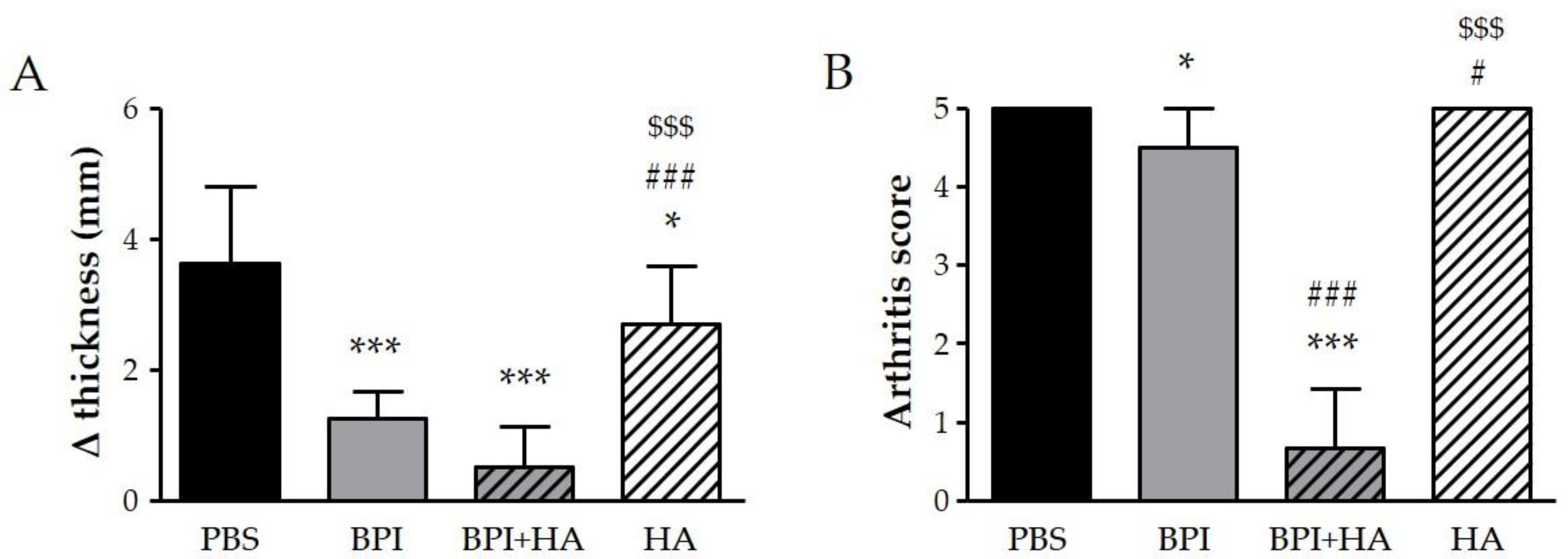
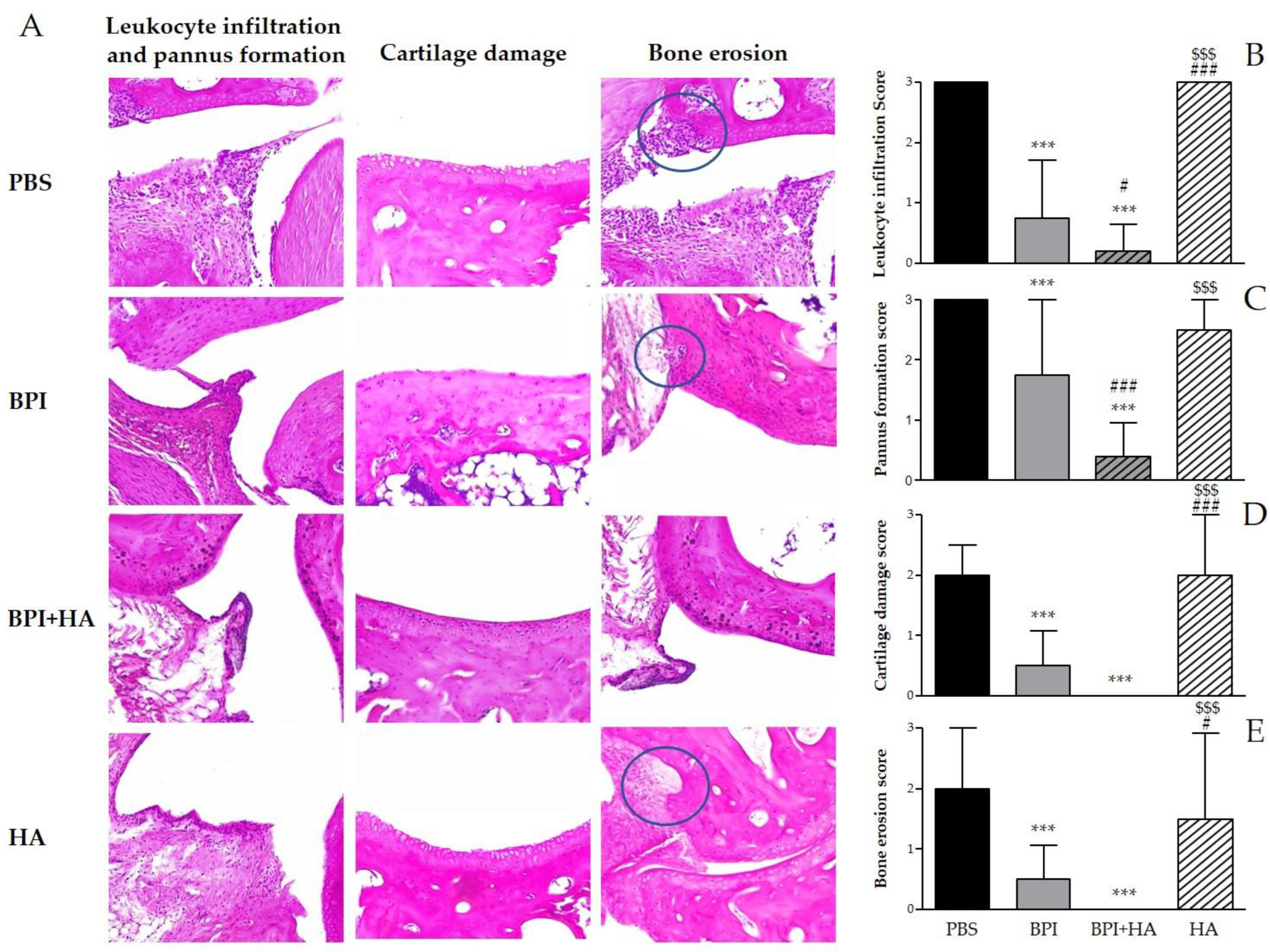
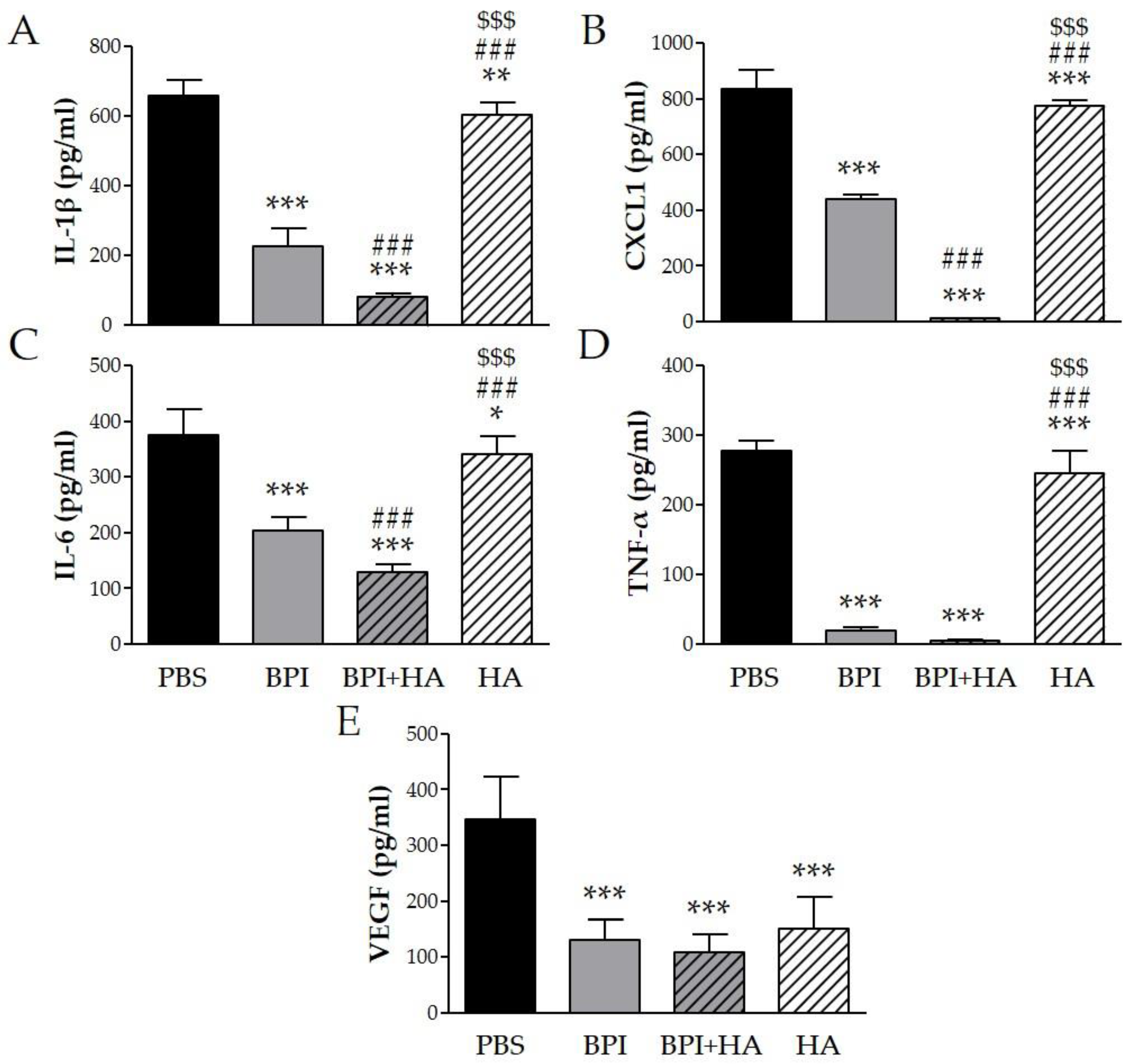
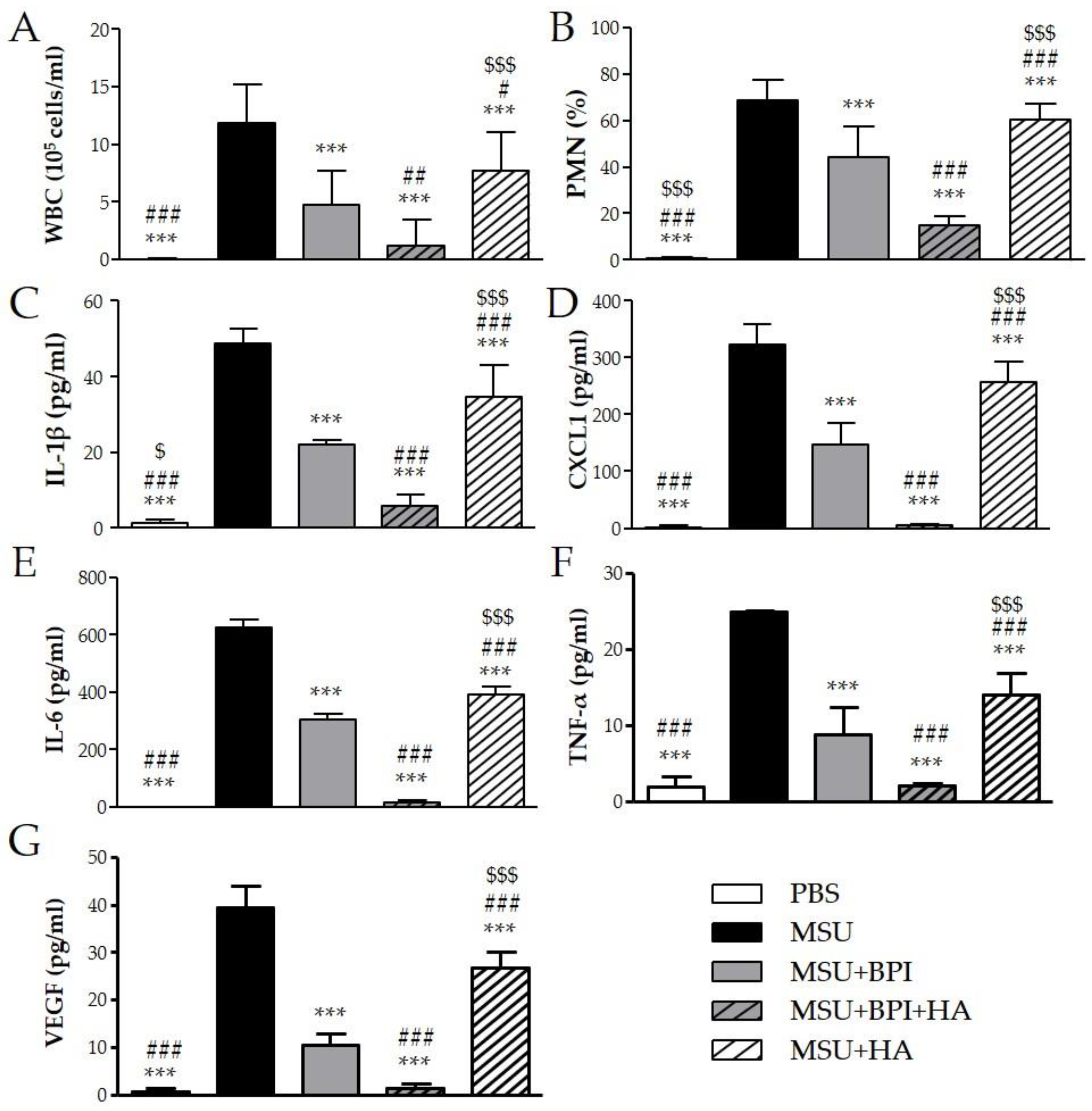
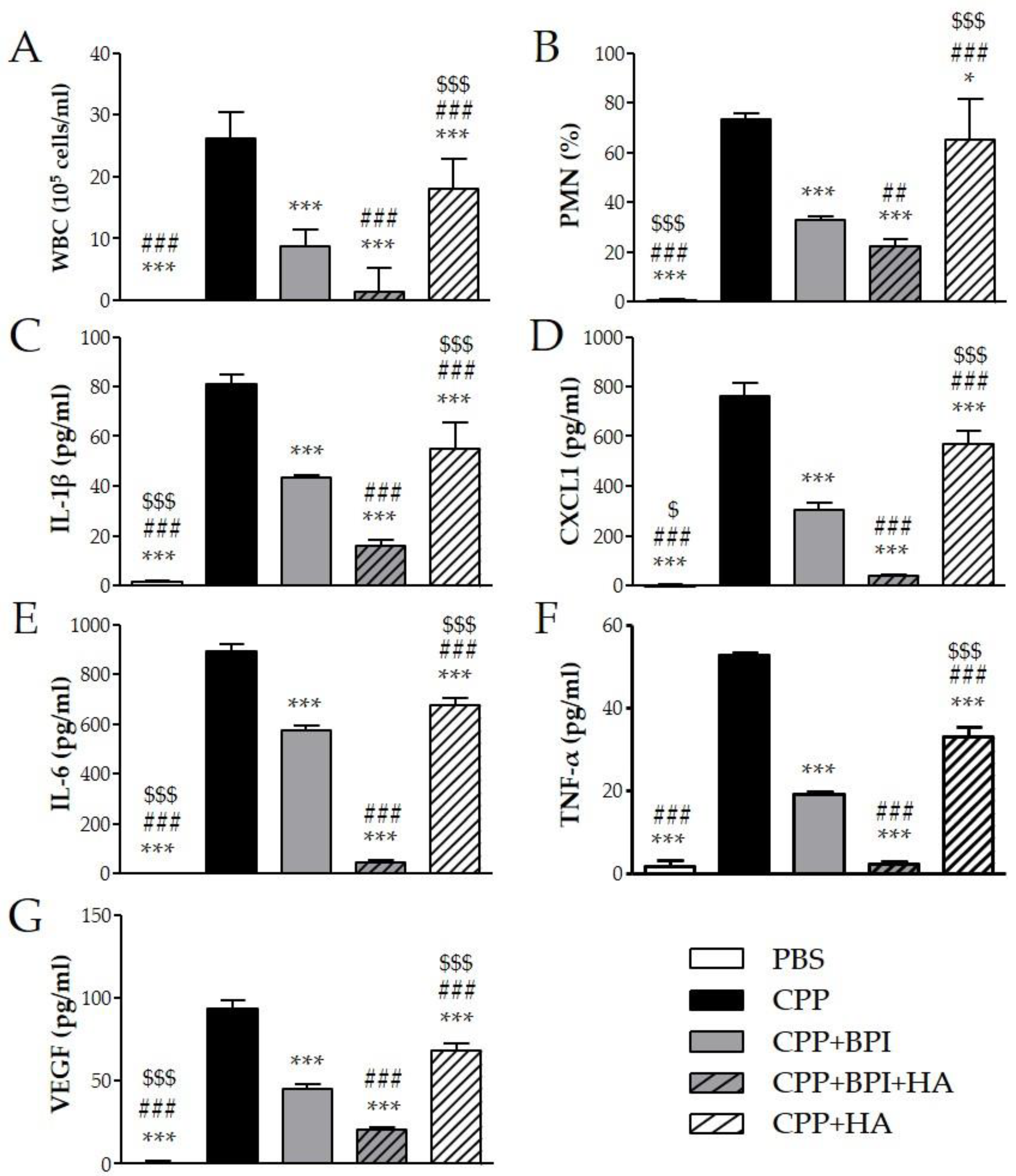

Publisher’s Note: MDPI stays neutral with regard to jurisdictional claims in published maps and institutional affiliations. |
© 2022 by the authors. Licensee MDPI, Basel, Switzerland. This article is an open access article distributed under the terms and conditions of the Creative Commons Attribution (CC BY) license (https://creativecommons.org/licenses/by/4.0/).
Share and Cite
Scanu, A.; Luisetto, R.; Oliviero, F.; Galuppini, F.; Lazzarin, V.; Pennelli, G.; Masiero, S.; Punzi, L. Bactericidal/Permeability-Increasing Protein Downregulates the Inflammatory Response in In Vivo Models of Arthritis. Int. J. Mol. Sci. 2022, 23, 13066. https://doi.org/10.3390/ijms232113066
Scanu A, Luisetto R, Oliviero F, Galuppini F, Lazzarin V, Pennelli G, Masiero S, Punzi L. Bactericidal/Permeability-Increasing Protein Downregulates the Inflammatory Response in In Vivo Models of Arthritis. International Journal of Molecular Sciences. 2022; 23(21):13066. https://doi.org/10.3390/ijms232113066
Chicago/Turabian StyleScanu, Anna, Roberto Luisetto, Francesca Oliviero, Francesca Galuppini, Vanni Lazzarin, Gianmaria Pennelli, Stefano Masiero, and Leonardo Punzi. 2022. "Bactericidal/Permeability-Increasing Protein Downregulates the Inflammatory Response in In Vivo Models of Arthritis" International Journal of Molecular Sciences 23, no. 21: 13066. https://doi.org/10.3390/ijms232113066
APA StyleScanu, A., Luisetto, R., Oliviero, F., Galuppini, F., Lazzarin, V., Pennelli, G., Masiero, S., & Punzi, L. (2022). Bactericidal/Permeability-Increasing Protein Downregulates the Inflammatory Response in In Vivo Models of Arthritis. International Journal of Molecular Sciences, 23(21), 13066. https://doi.org/10.3390/ijms232113066







